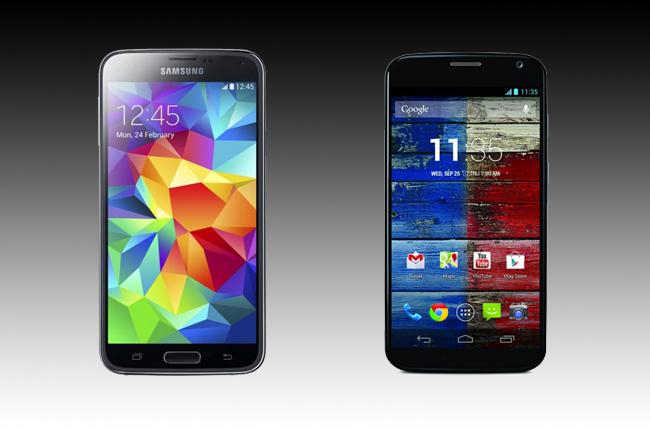
Samsung has been hard at work preparing for Mobile World Congress 2014 — and it shows. The most anticipated new product by far is the Galaxy S5, the next in a line of successful and popular Android-based devices. As expected, the company has made a number of appealing design changes sure to please fans of the Galaxy series of smartphones, most notably a larger screen, built-in fingerprint sensor, and submersible construction. But how does it compare to Motorola’s flagship smartphone, the Moto X? Check out our brief head-to-head comparison below to see which device comes out on top in terms of hardware, software, and overall functionality.
Also, check out our like-minded Samsung Galaxy S5 and Galaxy S4, or our Galaxy S5 and iPhone 5S comparison to see how Samsung’s new offering stacks up against its predecessor and Apple’s flagship smartphone.
Power and productivity
Both the Moto X and Galaxy S5 run on Snapdragon chips that are largely the same in terms of available functionality, with some notable exceptions. The Snapdragon S4 Pro in the Moto X runs two cores at 1.7GHz, and touts an ample 2GB of RAM reserved for games and demanding applications. However, the Galaxy S5 includes a new Snapdragon 801 chip, taking performance to a new level with a four cores running at an impressive 2.5GHz and an additional 2GB of RAM to back it up.
While both phones have motion processors, the Moto X is designed to figure out its current environment, and allows users to unlock the phone simply by picking it up. Alternatively, the Galaxy S5 tracks motion throughout the day, measuring your heart rate through a panel on the back. Morever, the Moto X lacks a card reader for external storage, likely rendering the device less appealing to users in need of more than the standard 16 or 32GB of storage.
Design
The design concept behind both smartphones couldn’t be more different. While the Moto X is available in a large number of colors and material options, and embellished in a comfortable curved-back casing, the Galaxy S5 essentially takes its predecessor’s construction and improves upon it with a waterproof encasing capable of being submerged for up to 30 minutes in less than three feet of water. The screen size on the S5 is larger and offers a higher resolution than the Moto X — 1080 x 1920 pixels compared to 720 x 1280 pixels — while taking advantage of Super AMOLED technology for a brighter, less reflective screen that uses less power. In addition, the S5’s super low-power mode ensures the device will use less power when the battery becomes low.
Camera
While the front-facing camera on the Samsung Galaxy S5 barely beats the camera in the Moto X in terms of raw megapixels, its rear-facing camera more than topples the Moto X with an astonishing 16 megapixels of auto-focusing goodness. The camera is even capable of recording 4K UHD video, and comes equipped with high dynamic range shooting and an LED flash. In comparison, both the 2MP front camera and the 10MP rear camera on the Moto X shoot 1080p video, with latter offering flash capabilities for shooting in darker environments.
Conclusion
While some of the specs of the Galaxy S5 show a drastic improvement over the Moto X, Motorola offers options that a good deal of users will find very attractive. Furthermore, we can expect Motorola’s next release to follow the Moto X with some serious competition fit for the newest addition in the Samsung Galaxy line.
The Samsung Galaxy S5 has been confirmed by AT&T and Sprint. It will be available on the Sprint network in April.
Editors' Recommendations
- A surprise phone just beat the Galaxy S24 Ultra in a big way
- 5 things I want to see in the Samsung Galaxy S25 Ultra
- Best Samsung Galaxy S24 deals: Save up to $800 on the phone
- Samsung Galaxy S24 Ultra vs. S21 Ultra: Do you need to upgrade?
- 5 things that made me fall in love with the Galaxy S24 Ultra





